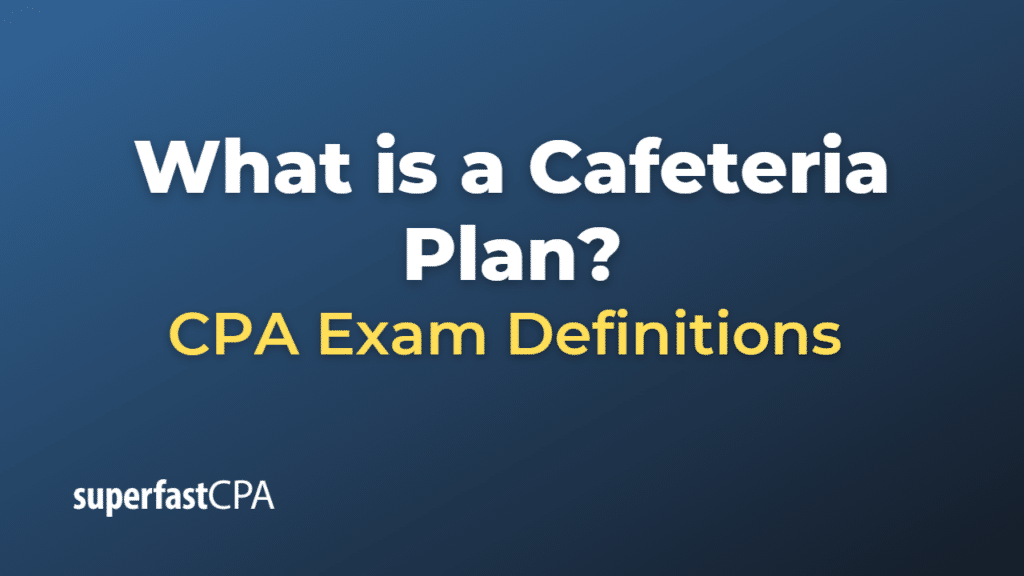Cafeteria Plan
A cafeteria plan, also known as a Section 125 plan or a flexible spending account (FSA), is a separate written plan maintained by an employer for employees that allows them to choose between receiving cash or certain qualified benefits on a pre-tax basis. Cafeteria plans are named after Section 125 of the Internal Revenue Code, which governs their use and provides specific tax advantages for both employees and employers.
In a cafeteria plan, employees can allocate a portion of their pre-tax salary to pay for qualified benefits such as health insurance premiums, dependent care expenses, or medical expenses not covered by insurance. By doing so, employees reduce their taxable income, which in turn reduces their income tax and Social Security (FICA) tax liability.
Some common features of cafeteria plans include:
- Pre-tax contributions: Employees can allocate a portion of their salary to the cafeteria plan before taxes are withheld, reducing their taxable income and overall tax liability.
- Flexible spending accounts (FSAs): These are accounts that employees can use to set aside pre-tax dollars for qualified medical or dependent care expenses. FSAs have annual limits on contributions and typically require that funds be used within the plan year or be forfeited, though some plans may allow a grace period or a limited carryover of unused funds.
- Health savings accounts (HSAs): Some cafeteria plans may include HSAs, which are tax-advantaged accounts that can be used to pay for qualified medical expenses for individuals enrolled in a high-deductible health plan (HDHP). HSAs have their own contribution limits and rules regarding rollovers and withdrawals.
Cafeteria plans are beneficial for both employees and employers. Employees can save on taxes by paying for qualified benefits with pre-tax dollars, while employers can save on payroll taxes since the amounts contributed to the plan by employees are not subject to Social Security and Medicare taxes. However, cafeteria plans must comply with specific IRS rules and regulations, and it is important for employers to administer them properly to avoid potential tax penalties or the loss of the plan’s tax-advantaged status.
Example of a Cafeteria Plan
Let’s consider a hypothetical example of a cafeteria plan in action.
Imagine that you work for a company called “GreenTech Solutions,” which offers its employees a cafeteria plan as part of their benefits package. During the annual open enrollment period, you are given the option to allocate a portion of your pre-tax salary to various qualified benefits available through the plan.
You decide to allocate $2,500 to a medical flexible spending account (FSA) to cover out-of-pocket healthcare expenses and $5,000 to a dependent care FSA to help pay for your child’s daycare expenses. Additionally, you choose to have $3,600 of your salary directed toward your health insurance premiums.
By participating in the cafeteria plan, you reduce your taxable income by a total of $11,100 ($2,500 + $5,000 + $3,600). This lowers the amount of income tax and Social Security (FICA) tax you have to pay. Assuming you are in the 22% federal income tax bracket, you would save approximately $2,442 in federal income taxes alone ($11,100 x 22%). Additionally, you would save on Social Security and Medicare taxes, further increasing your overall tax savings.
GreenTech Solutions also benefits from offering the cafeteria plan, as the $11,100 you contribute is not subject to the company’s portion of Social Security and Medicare taxes. This results in savings for the employer as well.
However, it’s essential to remember that FSAs typically have a “use it or lose it” rule, meaning you must use the funds you contribute to these accounts within the plan year or risk forfeiting any unused balance. Some plans may offer a grace period or allow for a limited carryover of unused funds, but it is crucial to understand your plan’s specific rules and requirements to maximize your benefits.













